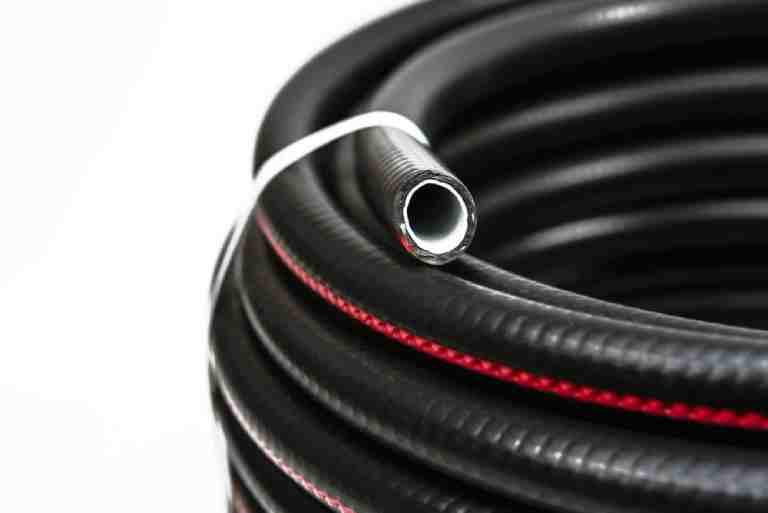Rubber hoses are everywhere in industrial plants. They are wrapped around fittings, moving fluid and handling pressure. Despite their simple appearance, they are highly engineered components that withstand extreme conditions.
Let’s break down what goes into these essential components.
What’s a Rubber Hose Anyway?
A rubber hose is more than just a tube. Usually, an industrial rubber hose has three layers:
- The inner tube carries the fluid. It needs to be compatible with whatever’s flowing through.
- The reinforcement layer is made of textile, wire braid, or spiral wire. This handles the pressure.
- The outer cover protects against the environment, like abrasion, oil, ozone, UV, and fire.
The inner tube and outer cover use specially formulated elastomer compounds. These compounds are suitable for the system’s environment. Based on the requirements, the rubber hose manufacturer may also add optional layers. For instance, static wire, insulation, or corrugations.
Also Read: What Is a Rubber Hose? Types, Applications, and Benefits
Design: Fit for Function
No two applications are the same. Consequently, hose designing starts with the STAMPED method.
- Size (inside diameter, outside diameter, and length)
- Temperature (ambient and media)
- Application (specific use-case details)
- Media (the substance conveyed)
- Pressure (working and burst)
- Ends (fittings or connectors)
- Delivery (logistics, installation, or urgency requirements)
STAMPED directly affects the performance, safety, and service life of the hose. Miss even one, and you risk hose failure. And failure is dangerous in high-pressure systems.
For example:
- A steam hose must be suitable for temperatures over 200°C.
- Similarly, a suction hose for slurry needs to be flexible and support vacuum.
Material Selection: It’s All in the Compound
Different materials are selected based on compatibility with:
- Conveyed media
- Operating temperatures
- Mechanical stress
- Regulatory compliance
Some commonly used elastomers in industrial hose manufacturing include:
- Nitrile Rubber (NBR): Excellent oil, fuel, and grease resistance. As a result, it is commonly used in hydraulic, fuel, and oil transfer hoses.
- EPDM (Ethylene Propylene Diene Monomer): Ideal for high-temperature steam, hot water, and outdoor use. In addition, it offers outstanding ozone and weather resistance.
- Chloroprene (Neoprene): Moderate oil resistance with flame-retardant properties. Therefore, it is used in welding and multipurpose hoses.
- SBR (Styrene-Butadiene Rubber): Cost-effective and durable for general-purpose air and water hoses.
- Viton® (FKM): A high-performance fluoroelastomer known for its exceptional chemical and high-temperature resistance. Consequently, it is used in highly demanding applications.
Proper material selection also considers aspects like:
- Hose’s durometer: How hard or soft the material is. High durometer means the hose is harder and less flexible.
- Permeation rate: How fast can liquids or gases pass through the hose if there’s no leak.
- Compression set: How much material stays squished after being compressed. If it does not return to its original shape, it may leak or not seal properly.
- Resilience under cyclic loading: Repeated changes in pressure, bending, and stretching is called cyclic loading. Resilient hoses handle this kind of stress without losing function over time.
Performance: Beyond Holding Together
The hose fits well and doesn’t leak. But that’s not enough. It must also maintain flexibility under cold or elevated temperatures, handle bending, resist kinking, and endure repeated loading cycles.
Some of the key performance parameters are as follows:
- Working Pressure vs. Burst Pressure: Most hose designs have a 4:1 safety factor. This means that the burst pressure is four times the rated working pressure.
- Bend Radius: The hose’s minimum radius can bend without kinking or damaging the internal reinforcement.
- Vacuum Rating: For suction or negative pressure applications, spiral wire reinforcement helps prevent collapse.
- Abrasion Resistance: This is especially important in material transfer hoses like sandblast, concrete, or slurry hoses.
- Ozone and UV Resistance: Vital for outdoor applications to prevent premature aging and cracking of the outer cover.
- Static Dissipation: To prevent electrostatic discharge in flammable media, embedded static wires or conductive rubber compounds are used.
Finally, standardized tests such as burst testing, flex fatigue, ozone chamber aging, and temperature cycling validate each performance metric.
Also Read: How to Maintain Rubber Hose Pipes for Long-Lasting Performance
Final Thoughts
The engineering of rubber hoses is far from basic. In industrial systems, the hose is a connector designed to withstand complex and demanding conditions. Therefore, selecting the correct hose involves understanding design fits, material behavior, and performance characteristics. When chosen and installed correctly, a quality industrial rubber hose ultimately contributes to operational efficiency, safety, and cost savings.
Shree Rubber Works is your trusted rubber hose manufacturer and supplier in India. Our hoses are designed for air, water, oil, fuel, and chemical transfer. As a result, they feature reinforced construction to survive extreme temperatures, high pressure, and abrasion.
If you are looking for a rubber hose manufacturer, look no further. Get in touch with us today!

